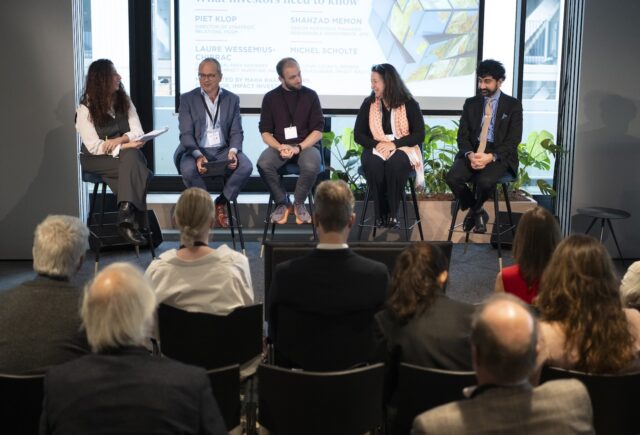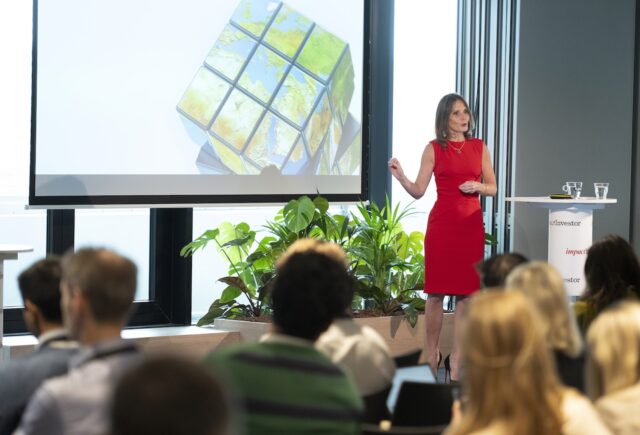It’s hard to get some stakeholders out of their silos, but once they get talking, impact investing can get a lot more effective, according to speakers at philanthropy and investment conference in London

In brief
- Despite the challenges of working across organisations and disciplines, the benefits of collaboration in the philanthropic and investment sectors are clear
- During a conference focused on new frontiers in funding, philanthropy and investment, delegates heard that single projects don’t change systems and that deeper multi-stakeholder collaboration is needed
- Call for pension funds to use their clout to effect change
Working across organisations and disciplines to bring to maximise the benefits of impact investments usually requires organisations with very different risk-return profiles to work to a shared vision, often across multiple projects – and that may be easier said than done.
But gains on offer make perseverance with such complex initiatives worthwhile, according to participants at the Joseph Rowntree Foundation’s conference on new frontiers in funding, philanthropy and investment, held in London last week.
“We are all running these big projects that are really ambitious. We’re working really hard. Then, suddenly you realise single projects don’t change systems,” Ivana Gazibara, a futures and systems change expert at the TransCap Initiative[IL2] told the conference. TransCap – which grew out of EU climate innovation initiative EIT Climate-KIC – aims to foster systemic investing by involving multiple stakeholders.
Caroline Mason, CEO of Esmée Fairbairn Foundation (EFF), a UK-based environmental and social investor recently profiled by Impact Investor, said the benefits of wider stakeholder collaborations are clear.
“We now don’t do anything on our own, we do everything in partnership with others – that’s a new role for us, and it’s not necessarily all in the not-for-profit space either,” she said.
EFF now has a strategy of seeking out what she called “unusual alliances”, bringing together people from different sectors, including government agencies, banks, and those whose livelihoods are affected to do achieve greater impact.
However, alliances involving more than one or two diverse actors for impact projects are still relatively thin on the ground.
This is partly due to the differing risk tolerance of stakeholders. However, impact-oriented an investment fund or pension fund’s policy may be, they still have to provide a return for investors and safeguard their money, perhaps over decades, whereas a grant provider, for example, will often just be seeking to make the biggest impact possible.
But it’s also because it is still hard to shift potential partners from their individual silos to collaborate with others who have a stake in a given investment decision to work out how money could be best spent.
“No one thinks they’re the bad guy”
Sarah Teacher, executive director of UK-based advocacy and educational organisation the Impact Investing Institute, said that her experience working in philanthropy, corporate consultancy, investment management and now the institute, showed that issues such as racial inequality, regional economic disparities and the impact of de-industrialisation had been ill-served by the failure of different players to collaborate.
“These people rarely talk to each other, no one goes to work thinking they’re the bad guy,” she told the conference.
In an effort to change that, the institute has been promoting closer cooperation between stakeholders, for example by looking at how investors such as local government pension schemes and financial institutions can better direct their investments. It has been working with Lloyds Banking Group and local authorities to show how the bank could adapt its local lending strategy to help meet local priorities.
The institute is now part of a structurally more ambitious pilot project to stimulate investment in a local area by bringing together pension funds, charitable foundations, social investors, local anchor institutions and local communities to identify investment opportunities in Wakefield, northern England, which has some of the most deprived neighbourhoods in the UK.
“I assumed all these local anchor institutions would all know each other, but at our first meeting, none of them had spoken to each other,” Teacher said.
It didn’t take long to get the Wakefield collaboration rolling. Within two hours, the group was discussing how to bundle potential investment destinations together in a package that would provide investable opportunities. “That’s a relational ecological way of working that we think will yield better outcomes overall, she said.
“Challenge your pension provider”
Large commercial players also have a role to play in overseeing closer cooperation in impact investing across the economy, given their global reach and financial clout, according to Maria Larsson Ortino, global ESG manager at asset manager Legal & General Investment Management (LGIM).
“Having £1.4tn of assets under management helps to get yourself heard. We are a universal owner, which means we hold shares in every listed company. As a shareholder, we have a right to speak to the company, we have a seat at the table and that’s really important. We could be silent, but we talk to the company and challenge them,” she said.
To take one case, LGIM is active in collaborative efforts with medical institutions and industry to pressure multinational food and drink companies to change the way they market products to children and improve the nutritional content of their products.
She urged pension holders to apply more pressure to their providers.
“Think about your pension provider and challenge them. If it’s us, please challenge us. Are they really doing what they say they’re doing? How are they voting with the shares that they hold on your behalf?” she said.
Priorities need to changed
There’s still plenty of work to be done to change thinking within the financial sector on maximising investment impact. Funds still tend to favour investments in individual companies or technologies, with an eye on the likely financial returns, rather than taking a holistic view of what would work best for the supposed beneficiaries.
“Success is still framed is around picking a few winners and achieving a competitive return, while also achieving stated social or environmental impact on the side. What we want to do is flip that on its head,” said TransCap’s Gazibara.
So rather than starting with profit imperative or an ESG framework, investors needed to define the challenge to be met and then structure their mission around that. “How you build your portfolio and deploy your capital is fundamentally about making investments, however small or big, that have an outsized impact and work in service of that mission,” she said.
TransCap is currently in the early stages of a project to show how this can work, collaborating with a finance partner to structure an investment vehicle for net-zero mobility in Switzerland.
“We’re doing the system mapping, identifying the leverage points for transformation of that market, understanding the investable universe, structuring what necessarily has to be a multi-asset-class investment vehicle,” she said.





